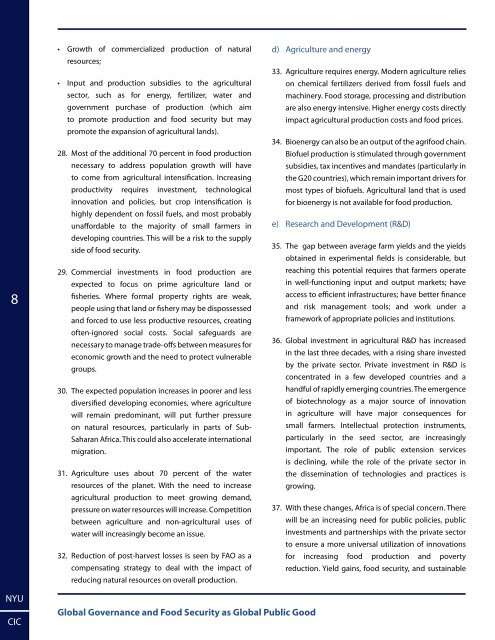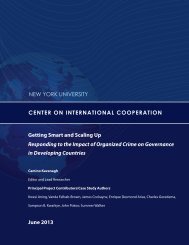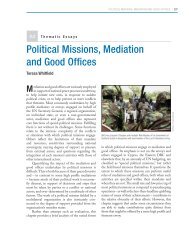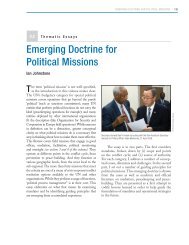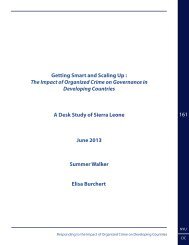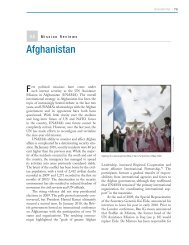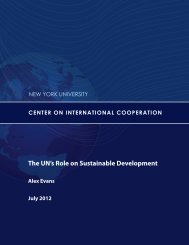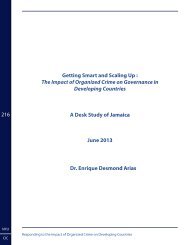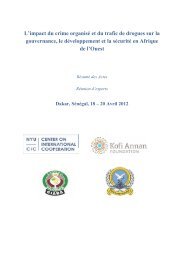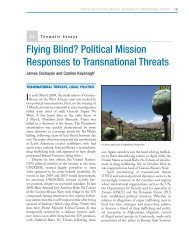Global Governance and Food Security as Global Public Good
Global Governance and Food Security as Global Public Good
Global Governance and Food Security as Global Public Good
You also want an ePaper? Increase the reach of your titles
YUMPU automatically turns print PDFs into web optimized ePapers that Google loves.
8• Growth of commercialized production of naturalresources;• Input <strong>and</strong> production subsidies to the agriculturalsector, such <strong>as</strong> for energy, fertilizer, water <strong>and</strong>government purch<strong>as</strong>e of production (which aimto promote production <strong>and</strong> food security but maypromote the expansion of agricultural l<strong>and</strong>s).28. Most of the additional 70 percent in food productionnecessary to address population growth will haveto come from agricultural intensification. Incre<strong>as</strong>ingproductivity requires investment, technologicalinnovation <strong>and</strong> policies, but crop intensification ishighly dependent on fossil fuels, <strong>and</strong> most probablyunaffordable to the majority of small farmers indeveloping countries. This will be a risk to the supplyside of food security.29. Commercial investments in food production areexpected to focus on prime agriculture l<strong>and</strong> orfisheries. Where formal property rights are weak,people using that l<strong>and</strong> or fishery may be dispossessed<strong>and</strong> forced to use less productive resources, creatingoften-ignored social costs. Social safeguards arenecessary to manage trade-offs between me<strong>as</strong>ures foreconomic growth <strong>and</strong> the need to protect vulnerablegroups.30. The expected population incre<strong>as</strong>es in poorer <strong>and</strong> lessdiversified developing economies, where agriculturewill remain predominant, will put further pressureon natural resources, particularly in parts of Sub-Saharan Africa. This could also accelerate internationalmigration.31. Agriculture uses about 70 percent of the waterresources of the planet. With the need to incre<strong>as</strong>eagricultural production to meet growing dem<strong>and</strong>,pressure on water resources will incre<strong>as</strong>e. Competitionbetween agriculture <strong>and</strong> non-agricultural uses ofwater will incre<strong>as</strong>ingly become an issue.32. Reduction of post-harvest losses is seen by FAO <strong>as</strong> acompensating strategy to deal with the impact ofreducing natural resources on overall production.d) Agriculture <strong>and</strong> energy33. Agriculture requires energy. Modern agriculture relieson chemical fertilizers derived from fossil fuels <strong>and</strong>machinery. <strong>Food</strong> storage, processing <strong>and</strong> distributionare also energy intensive. Higher energy costs directlyimpact agricultural production costs <strong>and</strong> food prices.34. Bioenergy can also be an output of the agrifood chain.Biofuel production is stimulated through governmentsubsidies, tax incentives <strong>and</strong> m<strong>and</strong>ates (particularly inthe G20 countries), which remain important drivers formost types of biofuels. Agricultural l<strong>and</strong> that is usedfor bioenergy is not available for food production.e) Research <strong>and</strong> Development (R&D)35. The gap between average farm yields <strong>and</strong> the yieldsobtained in experimental fields is considerable, butreaching this potential requires that farmers operatein well-functioning input <strong>and</strong> output markets; haveaccess to efficient infr<strong>as</strong>tructures; have better finance<strong>and</strong> risk management tools; <strong>and</strong> work under aframework of appropriate policies <strong>and</strong> institutions.36. <strong>Global</strong> investment in agricultural R&D h<strong>as</strong> incre<strong>as</strong>edin the l<strong>as</strong>t three decades, with a rising share investedby the private sector. Private investment in R&D isconcentrated in a few developed countries <strong>and</strong> ah<strong>and</strong>ful of rapidly emerging countries. The emergenceof biotechnology <strong>as</strong> a major source of innovationin agriculture will have major consequences forsmall farmers. Intellectual protection instruments,particularly in the seed sector, are incre<strong>as</strong>inglyimportant. The role of public extension servicesis declining, while the role of the private sector inthe dissemination of technologies <strong>and</strong> practices isgrowing.37. With these changes, Africa is of special concern. Therewill be an incre<strong>as</strong>ing need for public policies, publicinvestments <strong>and</strong> partnerships with the private sectorto ensure a more universal utilization of innovationsfor incre<strong>as</strong>ing food production <strong>and</strong> povertyreduction. Yield gains, food security, <strong>and</strong> sustainableNYUCIC<strong>Global</strong> <strong>Governance</strong> <strong>and</strong> <strong>Food</strong> <strong>Security</strong> <strong>as</strong> <strong>Global</strong> <strong>Public</strong> <strong>Good</strong>


